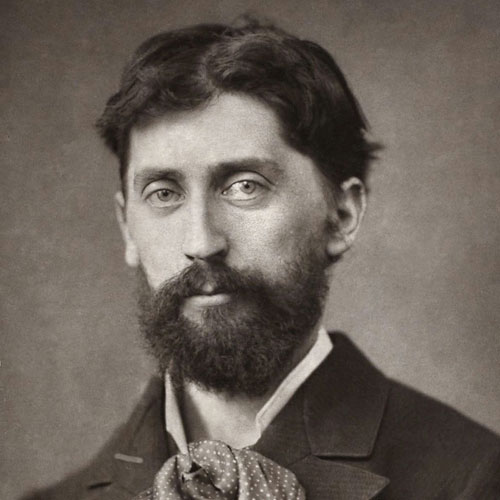The painter

Georges Moreau de Tours was born at Ivry–sur-Seine and died at Bois-le-Roi, Seine et Marne, where he lived with his family. His work is the precious testimony of the great currents of thoughts during the second half of the 19th century in France, when Orientalism, psychiatric research and a renewal of patriotism inspired Romantic and Symbolist poets and artists. Towards the end of his life at Bois-le-Roi, in the Fontainebleau Forest, he was influenced by the plein-air artists and the Impressionists. Thérèse de Champ Renaud, Moreau de Tours, his pupil, model and wife, also became a well-known artist.
Life & work
Georges Moreau de Tours was born at Ivry-sur-Seine on the 3rd of April 1848 in the Maison de Santé Esquirol (named after his father’s mentor, Jean Étienne Esquirol, director of the Maison Royale de Charenton, the mental asylum). His father Jacques-joseph Moreau (1804-1884), the famous psychiatrist from Touraine hence the addition to his name de Tours, was the director of the clinic. His first-born son, Paul Moreau de Tours, also a psychiatrist, took over the clinic after his father’s death in 1884. Georges started some law studies and gave them up to join the École Nationale et Spéciale des Beaux-Arts on October 25th 1870, Section de Peinture et Sculpture, where he studied under Alexandre Cabanel (1823-1889), an academic painter of portraits and genre scenes.

He exhibited at the Salon for the first time in 1875, and from then onward his works were regularly shown there. The painting Cléopâtre exhibited in 1875, and the painting he submitted to the Concours du Prix de Rome in 1878, Ptolémée au tombeau d’Alexandre, together with the Egyptologue, 1882, now in the Musée des Beaux-Arts de Tours, are inspired by the current Orientalism and a taste for Egypt fostered on by the publication in 1858 of the novel Le Roman de la Momie by Théophile Gautier, a friend of his father, and in 1881 of Auguste Mariette’s death, who was with Champollion one of the founding fathers of Egyptology. From 1836 to 1837 Dr. Jacques-Joseph Moreau de Tours had travelled to the Near and Middle East with one of his patient and studied the clinical effects of the use of hashish on the human psyche.
In 1880 Georges Moreau de Tours won the Ville de Paris’s competition for the decoration of the Salle des Mariages in the Mairie of the 2e arrondissement with the painting Le Sacrifice à la Patrie. The sketches for the two paintings Le Mariage and La Famille, hung by its side in this room realised in 1877 by one of Victor Baltard’s pupils, are in the Petit Palais in Paris. The three paintings were put into place in 1882.

His father, Dr. Jacques Joseph Moreau de Tours, was also a great lover of art and literature. Back in Paris he had gathered around him artists, writers and other personalities in the Hôtel Pimodan, the present Hôtel de Lauzun on the Île Saint-Louis, with whom he created in 1844 Le Club des Haschischins, described by Théophile Gautier in 1848 in his eponymous essay. There he conducted a study of paranormal states under the effects of narcotics, as related by Charles Baudelaire in 1860 in a chapter of the Paradis artificiels. Jacques-Joseph Moreau de Tours was a pioneer of psychic and psychological research, which Jean-Martin Charcot (1825-1893) carried on at the hospital La Salpêtrière. They both studied the clinical effects of hypnosis and hysteria, leading to the theory of psychic trauma. France was then leader in the field and Charcot influenced Sigmund Freud, one of his pupils.

Georges Moreau de Tours explored the subject in several of his works. He exhibited in the 1879 Salon Une extatique au XVIIIe siècle, épreuve de crucifiement , in 1885 Une stigmatisée au moyen-âge, in 1890 Les Fascinés de la Charité Service du Dr. Luys. The painting Les Morphinées exhibited at the 1886 Salon and described the same year by Guy de Maupassant in Chroniques, was reproduced in the Supplément Illustré du Petit Journal, 21st February 1891.
The influence of the literary circles around Moreau de Tours’s father can also be seen in several works on literary themes such as Goethe’s Faust et Marguerite, or Henrich Heine et la Muse de la Poésie, 1894. A sketch of the poet’s portrait was given by Georges Moreau de Tours to the Bois-le-Roi Mayor, Monsieur Louis Létang, a writer who held the post from 1892 till 1908, with the inscription : « À Monsieur Létang Maire de Bois le Roy Hommage de l’auteur G. Moreau de Tours ». This sketch is now at the Mairie of Bois-le-Roi.

An important part of Georges Moreau de Tours’s work is dedicated to the celebration of Republican patriotism and of the French State. A renewal of patriotism fired on the French nation after the defeat of Sedan in 1870 and Napoléon III’s fall. In this vein the scholarly collector of Napoleonic memorabilia, Paul Marmottan (1850-1932), a contemporary of Georges Moreau de Tours, supported the nationalist action of some members of the armed forces, collectors and artists who wanted to rise above the humiliation of Sedan in a celebration of the French Army at the 1889 Exposition Universelle. They launched an appeal for gifts in 1891 towards the creation of the Musée de l’Armée, and Marmottan became one of its founding members.
Georges Moreau de Tours exhibited four paintings at the 1889 Exposition Universelle, two of them were history paintings: La mort de Pichegru, 1886 et Le Drapeau. Assaut de Malakoff le 8 septembre 1855, bought by the State at the 1888 Salon, now in the Musée de Laval.

Georges Moreau de Tours’s ancestors had fought in the Napoleonic wars. His first cousin, Sophie Moreau, the widow of Dr. Bretonneau, friend and mentor of his father, the famous psychiatrist creator of the Club des Haschischins, Jacques-Joseph Moreau de Tours, had remarried in 1863 Justinien Nicolas, Comte Clary, Lieutenant Colonel and nephew of Désirée Clary. She was Bonaparte’s first fiancée, and wife of General Bernadotte, Prince of Pontecorvo and of the Empire, King of Sweden and Norway. Comte Clary seems to have played an important part in the painter’s life. In 1892 he presented him with the Légion d’Honneur, he was himself Commander of the Order, and in 1893 he was his witness at his wedding in Paris. In 1880 Moreau de Tours exhibited his first history painting La Tour d’Auvergne. Premier Grenadier de France mort au champ d’honneur. It was bought by the State and hung the same year in the Musée des Beaux-Arts in Quimper. Its reproduction in chromolithography in the Petit Journal Supplément Illustré ensured its large diffusion. This heroic and patriotic theme was used by the artist in several paintings shown at the Salon:
- 1886 La mort de Pichegru
- 1888 Le drapeau : assaut de Malakoff le 8 septembre 1855, Musée de Laval
- 1891 La Mort du polytechnicien Vaneau, 29 juillet 1830, École Polytechnique
- 1892 Vive la France, exécution de G. Gombald de Dinan, sergent au 2e tirailleurs à Ingolstad, janvier 1871, Château de Dinan, illustrated in a volume winner of a prize from the Académie Française, Histoire Générale de la Guerre Franco-Allemande, 1870-1871
- 1893 Au cabaret de Ramponneau, Musée de Colmar
- Lazare Carnot à la bataille de Wattignies 15 octobre 1793, Musée d’Evreux
- En avant, en avant ! La charge de Reichshoffen à la Bataille de Froeschwiller le 6 août 1870 (mort du colonel Franchessin)
- 1893 and at the 1900 Exposition Universelle Le départ du conscrit
Thérèse de Champ Renaud, Model, Pupil And Wife, Élève, The painter Thérèse Moreau de Tours (1861 – 1921)
In 1889 Georges Moreau de Tours was listed as liiving at 51 rue Claude Bernard, Paris 5e in the Catalogue Général Officiel, Exposition Universelle, and in 1897 in Jules Martin’s publication, Nos peintres et sculpteurs, graveurs, dessinateurs : portraits et biographies. He would have probably moved there after his father’s death in 1884. His wedding took place at his home on the 20th of April 1893 with his Swiss model and pupil, Thérèse de Champ Renaud (1861–1921) in presence of his doctor as he had suffered an attack of apoplexy after his mother’s death on March 25th 1893. Their three illegitimate daughters, now recognized, were born there: Jacqueline in 1886, Georgette in 1887, Sophie Germaine in 1890 – she died in December 1893 – as well as their son René born in 1895.


Thérèse had also studied at the Beaux-Arts with Cabanel and she was Georges Moreau de Tours’s only pupil. She painted landscapes, genre scenes in the open air, and in emulation of her husband’s work, some history paintings. She exhibited at the Salon from 1885 till 1893, and her name appears under Georges Moreau de Tours’s signature in 1891 on a painting depicting Le Maire de Rennes dated 1887. It was reproduced in the Supplément Illustré du Petit Journal of February 7th 1891 with the description « Tableau fameux de Mme Moreau de Tours ». This painting was bought in 2012 par le Musée de Bretagne in Rennes.
Le Retour, a painting depicting a Republican soldier’s home return from the army, probably in Alsace for the regional black satin bow at the back of the mother’s hair holding her child in her arms, was bequeathed to the Mairie of Bois-le-Roi in 2018.
In 1891 the review L’Illustration, SALON 1893 reproduced a seascape, Souvenir du Tréport, Mme G. MOREAU DE TOURS, née DE CHAMP-RENAUD. The same year Le Petit Journal, Supplément Illustré honored Georges Moreau de Tours and his wife Thérèse in illustrating Le Maire de Rennes on January 17th 1891, on February 7th Jeune Mère, Tableau de Mme de CHAMP-RENAUD, then on February 21th Les Morphinées, Tableau de M. MOREAU DE TOURS, and finally on August 22th 1891, La Petite Patriote, Tableau de Mme de CHAMP-RENAUD
In 1900 in the Paris Hachette Annuaire illustré, Georges Moreau de Tours is listed as resident in Bois-le-Roi under Adresses Mondaineswhere he had
bought a property probably in 1895. In 1871 a colony of artists, writers and
composers had settled there fleeing from the chaos of the Siege of Paris and of the Commune. Moreau de Tours’s father had also been a friend of Dr. Claudius Bureaud-Riofrey, Mayor of Bois-le-Roi from 1876 to 1881. During the census of 1900-1902, the painter’s family is listed after his death in 1901 at Bois-le-Roi, 224 avenue de la Gare, nowadays 79 avenue Foch. At this address were mentioned his widow Thérèse, their three children born in Paris : Jacqueline, fifteen years old, Georgette, thirteen, et René, six years old, together with a domestic.

His grand-daughter Simonne Hennape, who died in 2003, recalled their residence at the place called La Vignette, listed under the name Moreau de Tours on the 1904 cadastre on both sides of the Avenue de la Gare. The family owned several houses, one at number 77 on the actual avenue Foch, formerly 222 avenue de la Gare, where Thérèse’s mother, now remarried to Pierre Monfray, lived. They were both registered there from 1901 till 1911. There was another house at number 79, formerly 224 avenue de la Gare, where Thérèse was mentioned as a painter in the 1906 census with her two daughters: Jacqueline, a violin teacher, Georgette a pianist, and her son René together with a housekeeper. René went into business with his brother-in-law Charles Louis Lesot de la Panneterie, so-called de la Cressonnière, an actor on stage and in silent films, the husband of his sister Jacqueline, to transform the property 79 avenue Foch in a hostelry called La Grande Vignette. The Visitor’s Book dates from the 11th of July 1930.


The artist’s studio was situated opposite the house on the other side of the street, 64 avenue Foch. It became a ballroom where dances and theatrical performances where held until the sixties, when it was demolished. An annexe of the Grande Vignette, La Petite Vignette, had been built beside it 62 avenue Foch.

In 1893 soon after his mother’s death Georges Moreau de Tours had a stroke which partially paralysed the right side of his face. Some weeks later he married Thérèse, his family had hitherto always objected to the marriage because she was his model and a Protestant. The painter then gave up the large history paintings celebrating the French Republican and Imperial saga to concentrate on works of smaller size and different subjects. He now illustrated literary, poetical and musical themes, painted mostly plein-air scenes depicting Thérèse and his children, in particular the last one, his son René, landscapes and seascapes. These paintings show the clear influence of the School of Barbizon, a village nearby in the Fontainebleau Forest. Following the example of Corot and of John Constable, who had exhibited at the Paris Salon in 1824, a group of artists from 1825 to 1875 endeavoured to paint “en plein air et d’après nature”, ’in the open air and after nature’, which the manufacturing of oil paint in tubes made now possible. This is despite the fact that Constable’s The Haywain, to which Charles X awarded a Gold Medal at the Paris Salon of 1821, had been painted in the studio after sketches made out-of-doors, just as the large history paintings of which it assumed also the dimensions. The original title of the work had been Landscape. Noon, a clear indication of the artist’s conception of the work on a par with Claude Le Lorrain’s landscapes and those of the Dutch Masters such as Salomon and Jacob van Ruysdael.
Georges Moreau de Tours seems to have been very happy at Bois-le-Roi, enjoying a very close and harmonious family life. The love between he and Thérèse created a strong bond of tender complicity in a shared passion for their work. It had always been so despite all the obstacles they had to overcome to get married. This happiness is expressed in a lighter and more colourful palette in open-air scenes depicting a simple domestic felicity, such as Thérèse peignant dans le jardin de Bois-Le-Roi.

Thérèse was his only model and pupil, and if at the beginning of their marriage he depicted her in an academic style in religious, mythological and allegorical scenes, such as Le Sacrifice à la Patrie, his last manner shows a livelier style, more sensuous and luminous, close in palette and technique to the Impressionists. In the moving Portrait de Thérèse vue de dos, 1897, he expresses with great sensitivity all his love for the sensual and dazzling beauty of his wife.
Thérèse emulated her husband’s style and the various genres he worked in, such as La bataille de l’Alma. Zouave reprenant le drapeau de son régiment à l’ennemi, 1909. To such an extent that their two signatures can appear on the same painting as in Le Maire de Rennes in 1887, reproduced in the Supplément Illustré du Petit Journal 7th Febuary 1891 with the description Tableau fameux de Mme Moreau de Tours. Or some works can be attributed indifferently to the master or to the pupil, to the husband or to the wife, indicating a possible collaboration on some of them. Furthermore, after the death of Georges Moreau de Tours, Thérèse depicted herself in her own paintings in the same style as her husband used to, as if his loving eyes were still on her and alive in her art.
Her production was as prolific as her husband’s, she took part in many exhibitions where she is mentioned indifferently under the name of Thérèse Champrenaud, Thérèse Champ Renaud, Thérèse de Champ Renaud, or Thérèse Moreau de Tours
Georges Moreau de Tours died at Bois-le-Roi on the 11th of January 1901. He is buried together with Thérèse, who died in Paris in 1921, in the family vault, in the cemetary of Bois-le-Roi. In it are also buried their children with their spouses and close members of the family, among them Thérèse’s mother, Jeanne Monfray, née Hassler, widow of Louis Champ Renaud, who died at Bois-le-Roi in 1911. Some of Georges and Thérèse Moreau de Tours’s descendants still live in the village.
The rue de Longuives in Bois-le-Roi was renamed rue Moreau de Tours in 1930 after his son René’s gift to the Mairie in 1929 of the painting Ptolémée au tombeau d’Alexandre.
Bibliography
- Jean-Pierre Luauté, Les Moreau de Tours, Société, histoire et médecine, Éditions Glyphe, Paris, 2018
- Jules Martin, Nos peintres et sculpteurs, graveurs, dessinateurs : portraits et biographies, Paris, 1897
- Eugène Montrosier, Les artistes modernes, Tome Troisième, Librairie artistique, H. Launette Éditeur, Paris, 1882
- Monique Riccardi-Cubitt, Le peintre Georges Moreau de Tours (1848-1901) & sa famille entre Paris et Bois-le-Roi, Fontainebleau Revue d’Histoire de la ville et de sa région n°19, mai 2021, Société d’histoire de Fontainebleau et de sa région http://www.revue-histoire-fontainebleau.fr
- Antoine Ritti, Eloge de Jacques Moreau de Tours, Annales de la Société Médico-Psychologique, Paris, Octave Doin, 1887
Monique Riccardi-Cubitt
All rights reserved







 contact@amisdemoreaudetours.com
contact@amisdemoreaudetours.com
 @AssociationDesAmisDeMoreauDeTours
@AssociationDesAmisDeMoreauDeTours
 @amisdemoreaudetours
@amisdemoreaudetours